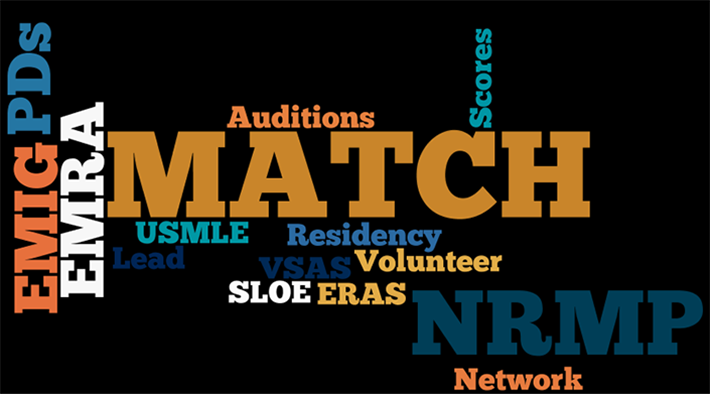EM Match 2023: An Osteopathic Student Perspective
Kyle Cohen, OMS III, MS, NRP, Alabama College of Osteopathic Coordinator
EMRA MSC Osteopathic Coordinator
Congratulations to the new emergency medicine interns!
The 2023 match in emergency medicine (EM) brought about some new challenges. EM has traditionally been fairly competitive until recent years. From 2012 to 2021, EM Match averaged only 10 unfilled positions in the main match. In that same time, the number of applicants from both DO and MD programs had steadily increased an average of 6% per year and the number of positions similarly increased. In the 2022 Match, those trends turned with a decrease in applicants by about 17% while the number of positions increased again by almost 3%, but there were still more overall applicants than positions. However, there were 219 unfilled positions after the main match and most of those positions filled during the SOAP. These trends continued in the 2023 match with another decrease in applicants by another 10% and an increase in positions by another 3%. For the first time, there were fewer applicants than there were positions and 554 unfilled positions after the match. While this may seem terrifying, the numbers of the 2023 match are similar to those of the 2019 match in terms of number of applicants and matches.
There is a lot of speculation as to why the numbers are the way they are, from the increased provider burnout, EM rotations during the surges of the COVID pandemic that may have deterred students or had rotations canceled, the ACEP Jobs Report released in 2021, and fear of advanced practice provider scope of practice changes. One fact that has been mentioned is the dramatic decrease in MD applicants in the 2022 and 2023 match of 8.7% and 20.5% respectively. While the number of DO applicants decreased as well, it was not as substantial at 1% and 4% respectively. EMRA President, Dr. Jessica Adkins Murphy, and EMRA Director of Education, Dr. Erin Karl, just did a fantastic EMRA Hangout discussing the recent match and workforce.
From an osteopathic student perspective, getting ready to begin the next audition and application cycle, it goes without saying that there is some uncertainty. There has been much talk about how our MD counterparts generally have earlier access to EM rotations, yet they have a greater decline in applicants than DO students. So if they are trending away from EM, what is keeping the DO student from trending away at the same rate? Whatever the reason, I believe the profession of EM is still strong.
While there are still programs that do not traditionally match DO students, it is believed that they may have to expand their search in order to avoid the SOAP or leaving positions unfilled. If you are reading this, you are likely already interested in EM, and programs should take note of that. It means that we are not scared of the uncertainty and are out right choosing this specialty and not hoping to use it as a back up plan.
With the decrease in number of applicants below the number of positions, this means that EM is essentially a “buyers market”. The only issue now is finding the program where you are the best fit. For the upcoming 2024 cycle, while CORD has not released their recommendations, it is believed that the recommendations will be largely unchanged. What this means is that each applicant should have two audition rotations with SLOEs, unless they have extenuating circumstances. So if you have a home program, that means only one away. In order to find that best fit, consider doing subspecialty rotations at programs of interest. Attend virtual open houses and follow those program social media pages. Lastly, EMRA has a number of program director interviews, either written or video, that provide a lot of information about the program in a concise format.
Recommendations Moving Forward
Early Elective - Many schools, particularly DO programs, do not require an EM rotation, and if they do, it is not a requirement until 4th year. If you have any interest in EM, it is encouraged that you take an early EM elective to see what the specialty is really about.
Shadowing shifts - If you are in an interest group leadership capacity, maybe you have potential to establish shadowing in your local emergency department to increase the exposure.
Mentor - If you don’t already have a mentor that is active in the residency process, It is also recommended that you seek out a mentor. The EMRA Medical Student Council has a mentorship program and you can be matched with a mentor that has volunteered to help out. You can sign up for a mentor here.
Latest Information - Lastly, seek out the most up to date information regarding the recommendations surrounding auditions, applications, and interviews. A couple of ways to do this is through the EMRA Hangouts that are held almost monthly and the EMRA Medical Student Forum that is held every spring and fall. This is also a great opportunity to network.
Networking - Networking is also an important component of being successful. Aside from the Hangouts and MSF, the EMRA Residency Program Fair is a great opportunity for you to meet program directors, faculty, and current residents. This year at ACEP23, it will be in person.
Related Content

Apr 25, 2023
EM Match 2023: An Osteopathic Student Perspective
The 2023 match in emergency medicine (EM) brought about some new challenges. EM has traditionally been fairly competitive until recent years. From 2012 to 2021, EM Match averaged only 10 unfilled positions in the main match. In that same time, the number of applicants from both DO and MD programs had steadily increased an average of 6% per year and the number of positions similarly increased. In the 2022 Match, those trends turned with a decrease in applicants by about 17% while the number of positions increased again by almost 3%, but there were still more overall applicants than positions





